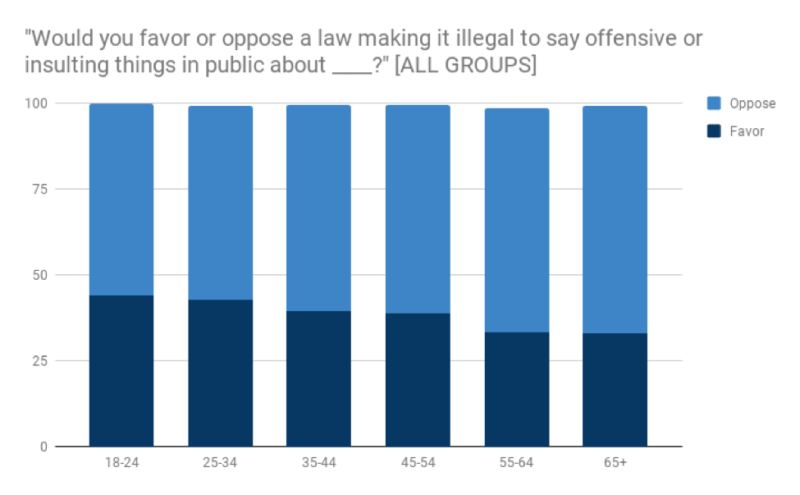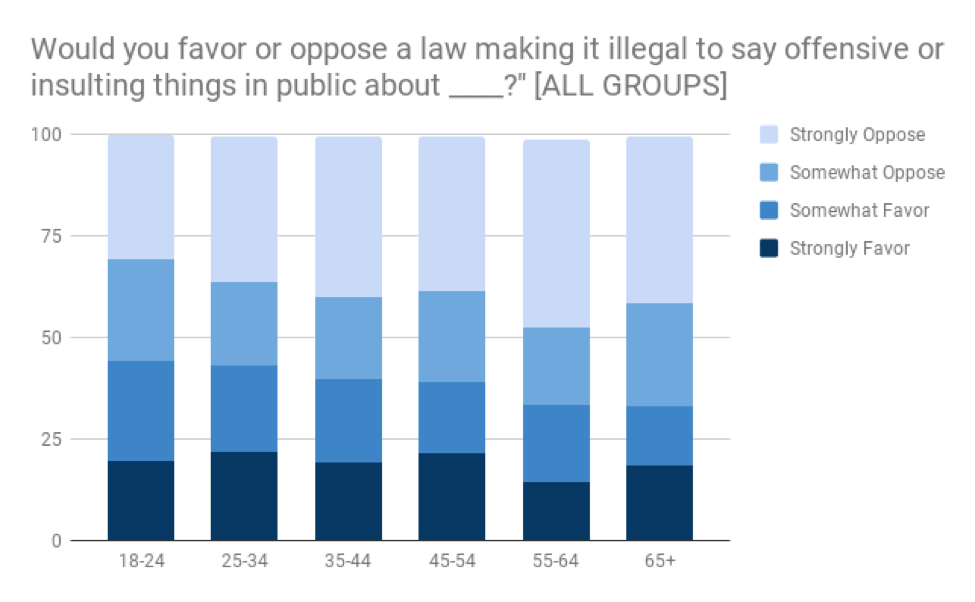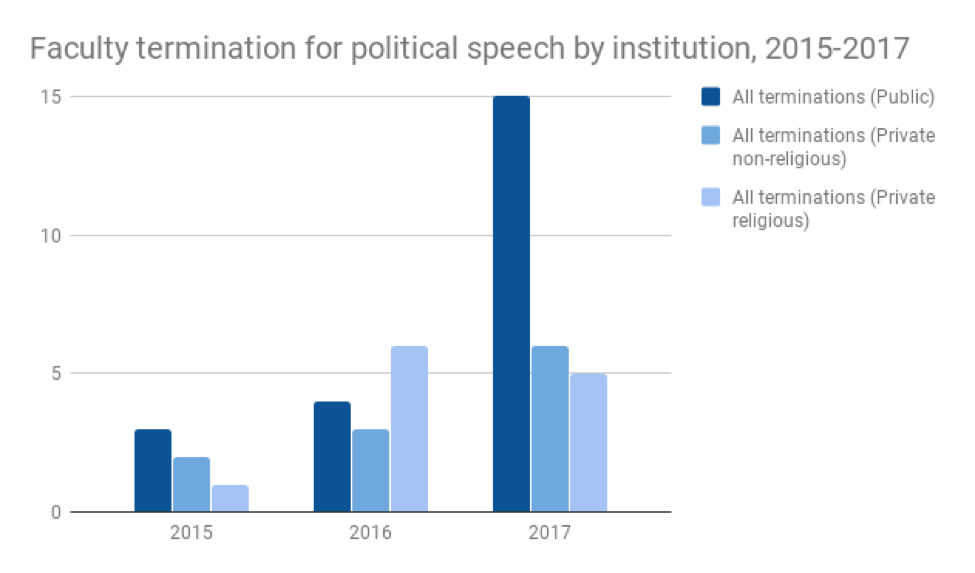The campus free speech debate is heating up. Last month I made the case (first in a Twitter thread and then again at the Washington Post’s The Monkey Cage) that there is no campus free speech crisis. Around the same time, similar arguments were made by Matt Yglesias (at Vox), Aaron Hanlon (at NBC), and Mari Uyehara (at GQ). The gist of our collective argument was that young people and university students are generally supportive of free speech, that university enrollment is associated with an increase in tolerance for offensive speech, and that a small number of anecdotes have been permitted to set the terms of public debate.
Unsurprisingly, these debunkings have attracted some debunkings of their own. The most detailed of these was a pair of posts by Sean Stevens and Jonathan Haidt at the Heterodox Academy. In addition to restating the case for why the campus free speech crisis is real, Stevens and Haidt make a number of additional claims for why alarm is warranted. I am grateful for their critique, but I am not persuaded.
The Claim: Young people aged 18-24 are significantly less supportive of free speech than older generations
In their two response pieces, Stevens and Haidt acknowledge that young people overall are supportive of free speech, but argue that those born after 1995 are different. For a variety of reasons (elsewhere Haidt has identified changes in child-rearing practices, the development of social media, and political polarization), young people aged 18-24 (Stevens and Haidt call them “iGen”) are much less tolerant of offensive speech than older Millennials or other Americans in general.[1]
The evidence does not support this claim. Stevens and Haidt place special weight on the results of a 2017 Cato/YouGov survey of Americans’ attitudes about various speech-related issues.[2] In particular, they focus on a set of questions asking whether respondents would support a ban on speech offensive to ten different kinds of groups (e.g. white people, Muslims, the police). On average, the youngest two age groups (18-24 and 25-35 year olds) support banning offensive speech 44% and 43% of the time respectively, whereas the two oldest age groups (55-64 and 65+ year olds) support them only 33% each.
So iGen is different, right? Not so fast. First of all, the Cato/YouGov survey asks dozens of other speech related questions and in many of them young people lead the way (e.g. in their support for freedom of the press). While I understand why Stevens and Haidt chose to focus on speech bans, I suspect they would agree that those questions tell us only part of the story.
And anyway, the story they tell does not support the iGen theory. A comparison between all generations (and not just the two youngest vs. the two oldest) shows that iGen’ers are much less out of the mainstream than Stevens and Haidt suggest.

Source: 2017 Cato/YouGov Free Speech and Tolerance Survey
Note: “Don’t know/refused” are excluded.
Figure 1: Support for banning offensive speech
Yes, if you look closely, you will note that iGen’ers are slightly more supportive on average of banning certain types of offensive speech than older generations, but there is no sudden spike or sweeping change. If these numbers are meant to show that iGen’ers are different, you need to really squint to see it.[3]
There are other problems with Stevens and Haidt’s theory. Not only are young people’s attitudes in line with national averages, but their intensity levels are too. This becomes obvious once we distinguish between degrees of support for speech bans, which the Cato/YouGov survey allows us to do.

Source: 2017 Cato/YouGov Free Speech and Tolerance Survey
Note: “Don’t know/refused” are excluded.
Figure 2: Support for banning offensive speech, with intensity
As this figure shows, not only are the opinions of iGen’ers within the mainstream, but so is the intensity with which they hold them. In fact, iGen’ers are less likely to strongly favor speech bans than 25-34 or 45-54 year olds, and are tied with 35-44 year olds. The upshot is that if you were on the hunt for a radical anti-free speech fringe, you would be better off looking among older Millennials or the middle aged.[4]
A decade of data from the Knight Foundation on high school students tells a similar story. Support for the First Amendment is currently at its strongest level yet recorded, with a majority of high schoolers (56%) disagreeing with the statement “The First Amendment goes too far in the rights it protects.” Note that there is no change during the years when iGen would be entering high school.
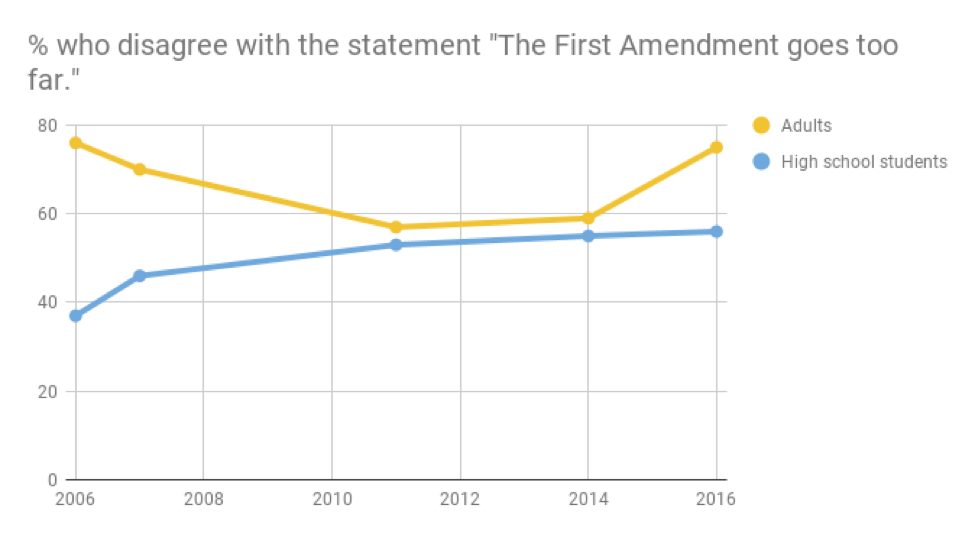
Source: 2016 Knight Foundation Future of the First Amendment Survey
Figure 3: Support for the First Amendment among high schoolers, 2006-2016.
High schoolers display similarly consistent levels of support when presented with specific speech-related scenarios. Again, the entry of iGen makes no visible difference.
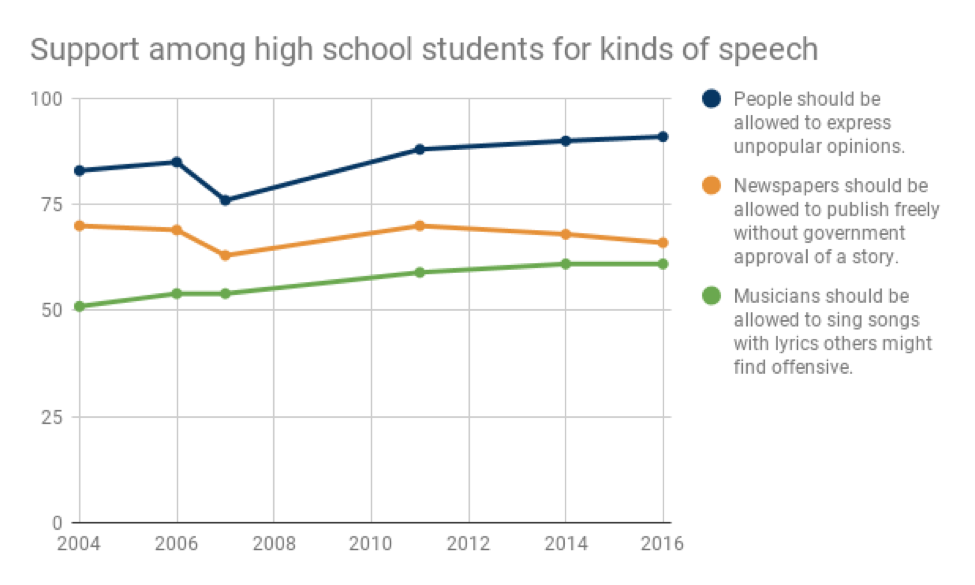
Source: 2016 Knight Foundation Future of the First Amendment Survey
Figure 4: Support for specific free speech scenarios among high schoolers, 2004-2016.
And contrary to Haidt’s theory about the relationship between social media and free speech, the Knight Foundation survey also found that high schoolers who actively engage with news on social media – discussing stories, posting comments, and linking to articles – consistently demonstrate greater support for free speech, not less.
But there is a deeper problem with Stevens and Haidt’s theory about iGen. Strictly speaking, their argument is not that young people are hostile to free speech. After all, young people do not stay young forever, and if their attitudes about free speech are just a function of age, then the “problem” will largely take care of itself. Instead, Stevens and Haidt argue that their attitudes are a function of cohort, and as such will endure over time.
Unfortunately, they do not present any evidence to substantiate this claim, and for an understandable reason – there is very little longitudinal data comparing generational support for free speech. But without that data, it becomes impossible to know whether iGen’ers are really different or just really young.
The Claim: There is a “politically correct” range of acceptable speech on campus, and it leans heavily to the left of the political spectrum
This claim may be correct, but we should be cautious about how we interpret it. Stevens and Haidt cite the 2017 Knight Foundation Free Expression on Campus survey showing a rise in the number of college students who say that “the climate on my campus prevents some people from saying things they believe because others might find them offensive”, from 54% in 2016 to 61% in 2017.
However, with only two data points to work with (there is no earlier data), it is impossible to know whether what we are seeing is random statistical noise or the beginnings of a trend. Moreover, this increase is being driven by perceptions of self-censorship among Democrats and Independents. The number of Republican students who reported a censorious climate on campus actually dropped from 62% to 53%.
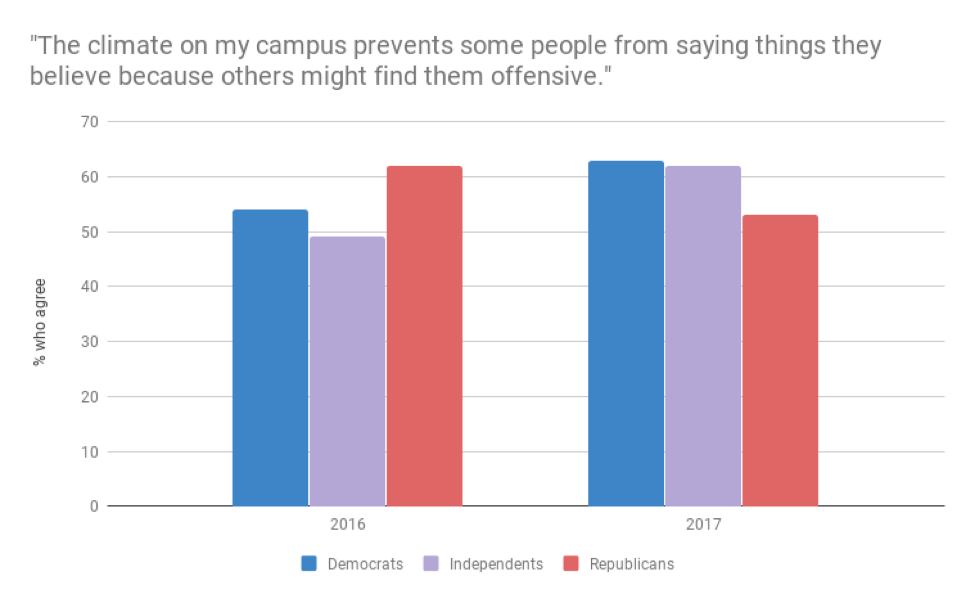
Source: 2017 Knight Foundation Free Expression on Campus survey
Figure 5: Perceptions of a censorious climate on campus, 2016-2017.
Even so, Stevens and Haidt are probably correct that liberal students have an easier time expressing themselves on campus. According to a 2017 FIRE/YouGov survey, conservative-leaning students were more likely to report that they censor themselves than liberal students, both in the classroom (60% vs. 53%) and outside of it (47% vs. 40%). And while most of this was due to a desire to fit in or avoid hurting someone else’s feelings, conservatives who self-censored were more likely than liberals to offer reasons like fear of receiving a poor grade from their professor (77% vs. 26%) or getting in trouble with a campus employee (17% vs. 5%).
These are concerning numbers, though the mechanisms at work need further study. Does the content of the speech matter? Are certain types of courses or classroom environments more censorious than others? How is the fear of retribution (from professors, administrative staff, other students, etc.) generated and distributed? More research is clearly needed.
However, it bears noting that Americans are, in general, a self-censoring people. Fifty-eight percent of us self-censor, according to the Cato/YouGov survey. And while the disparity between conservative and liberal self-censorship is real, it is actually smaller on campus than it is off. Conservative students self-censor less, and liberal students self-censor more, than do their counter-parts among the general population. In other words, to the extent that there is an ideological divide over political correctness in America, universities are a relative exception.
The Claim: The political left is a bigger threat to campus free speech than the political right
This final claim is the most subjective and therefore the most difficult to critically evaluate. Threats to free speech on campus can come from many directions, including from students, faculty, administrative staff, alumni, the local community, and politicians. Many of these may have no clear political identity or agenda as such, but are concerned instead with things like avoiding embarrassment or pleasing donors.
Nevertheless, politics can be a factor. Stevens and Haidt cite data from the Foundation for Individual Rights in Education’s (FIRE) Disinvitation Database to show that the political left is responsible for the vast majority of “disinvitation incidents”, defined as episodes in which members of the campus community attempt to block an outside speaker from speaking on campus.
But we should be skeptical of this conclusion. First of all, the Disinvitation Database is incomplete. It especially undercounts disinvitation incidents at religious colleges and universities, of which there have been many over the years. All of these examples were instigated by the right. All of them were successful. None are in FIRE’s database. And while some were cancelled due to quiet intervention by the university, others were the result of well-funded, nation-wide campaigns. Whatever the cause, the absence of these cases makes the imbalance between the left and the right seem much greater than it actually is.[5]
But even so, we should expect there to be more disinvitation attempts coming from the campus left than from the right. After all, that’s where more of the students are (35% vs. 22% of incoming freshmen, according to one recent survey). The implication of Stevens and Haidt’s argument is that liberal students are worse on free speech than conservatives. Maybe. Or maybe there are just a lot more of them.
Not convinced? Consider another way that free speech on campus might be threatened: terminating faculty for political speech. Are faculty whose speech is perceived to be political more likely to be fired due to criticism from the left or the right? It is an important question, one that reentered public debate recently following a Fresno State professor’s controversial remark.
To begin to answer this question, I gathered together all cases from 2015 to 2017 involving:
- a faculty member at an American degree-granting postsecondary nonprofit institution;
- who was fired, forced to resign/resigned as part of a settlement, or demoted/denied promotion;
- due to speech perceived by critics as political.
Sources included the Chronicle of Higher Education, Inside Higher Ed, AAUP, FIRE, and Campus Reform. You can view the resulting dataset here.
Inevitably there were ambiguous cases. Some involved professors who resigned over withering public criticism but retained the support of their institutions (e.g. Areej Zufari at Rollins College, Dale Brigham at the University of Missouri). In others, the evidence was suggestive but ultimately too thin to establish causation (e.g. Daniel Browning at William Carey College). Such cases were excluded from the dataset. On the other hand, I chose to include deans and comparable non-faculty academics (e.g. Nicholas Christakis at Yale University, N. Bruce Duthu at Dartmouth College) on the grounds that doing so contributes to an overall assessment of the campus free speech situation.
What remains are 45 cases from 2015 to 2017 where a faculty member was fired, resigned, or demoted/denied promotion due to speech deemed by critics as political. Of these, more than half (26) occurred in 2017, the clear majority (19) being over liberal speech. This disparity persists even after removing terminations occurring in private religious institutions.
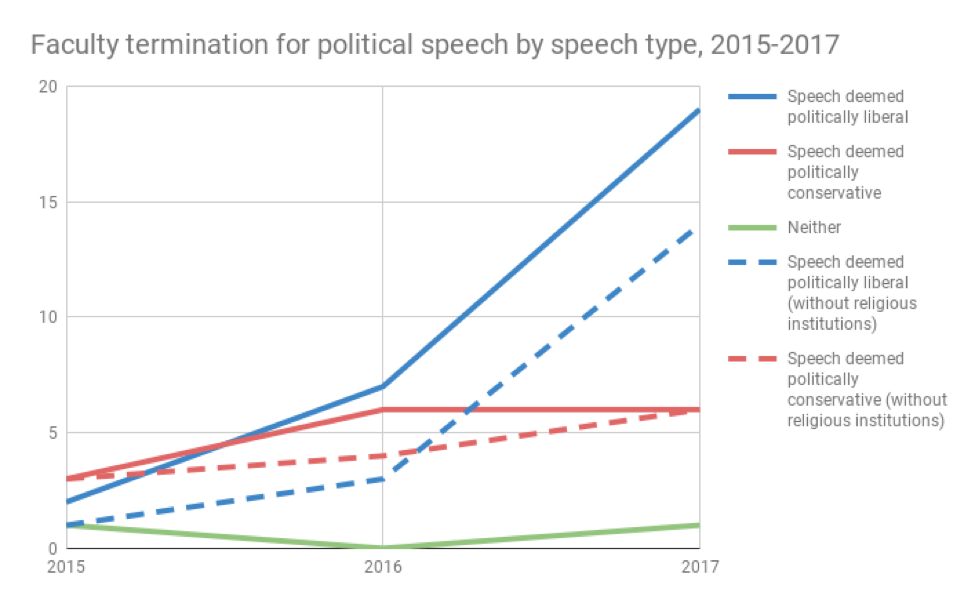
Source: The US Faculty Termination for Political Speech Database
Figure 6: Faculty termination by speech type, 2015-2017.
For liberals, the most common types of speech to result in termination were those perceived by critics as “anti-white” or “anti-Christian” (e.g. George Ciccariello-Maher, Phillip Lestman). For conservatives, they were “anti-minority” or “anti-diversity” (e.g. Susan Quade, Paul Griffiths).
These cases can be further analyzed in terms of faculty ranking, which show an especially sharp increase in 2017 in the number of terminations involving contingent faculty (e.g. adjuncts, visiting scholars, graduate student lecturers). However, due to data collection problems, this number probably significantly undercounts the phenomenon.[6]
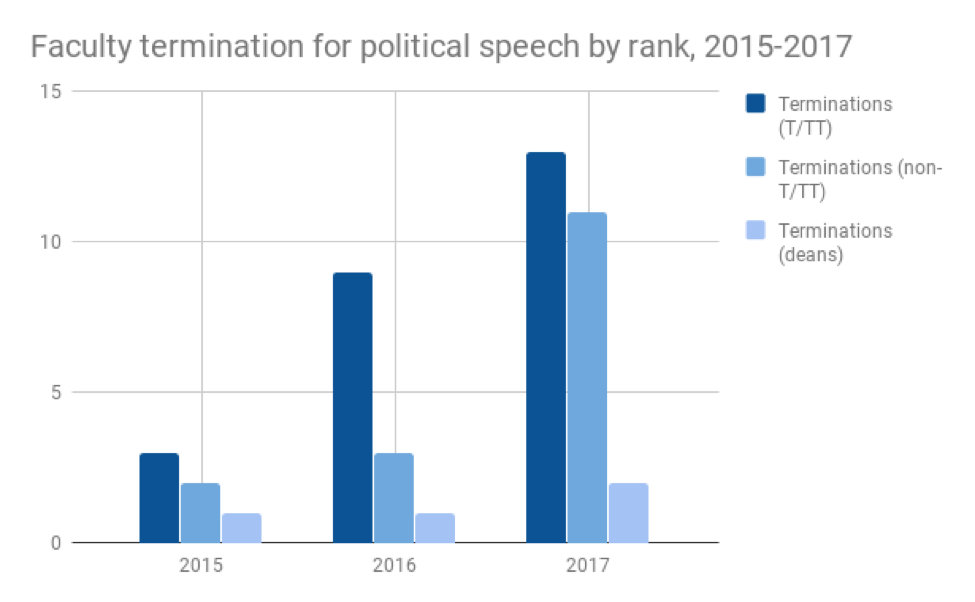
Source: The US Faculty Termination for Political Speech Database
Figure 7: Faculty termination by rank, 2015-2017.
And finally, most of the increase in faculty terminations is taking place at public institutions. Considering the First Amendment rights that such employees enjoy, this may be surprising. However it is important to keep in mind that public institutions also employ the vast majority of faculty. Also, note that due to categorization issues, these figures probably undercount the number of terminations at religious colleges and universities.[7]

Source: The US Faculty Termination for Political Speech Database
Figure 8: Faculty termination by institution, 2015-2017.
There are many ways to think about this data. The most straight-forwardly partisan one is to focus on the large disparity between terminations due to criticism from the right versus the left. Certainly there exists a vast infrastructure of organizations on the political right designed to monitor the academy and publicize disagreeable speech. No equivalent infrastructure exists on the left, perhaps explaining the disparity.
There is probably some truth to this explanation, but I would caution against relying on it too heavily. After all, the professoriate leans significantly to the left as well, so we should expect left-leaning speech to make up the bulk of terminations. As with the skewed findings of FIRE’s Disinvitation Database, we are not talking about a population where political ideology is uniformly distributed. It is possible for liberals to constitute the majority of faculty terminations and also for conservatives to be terminated at an equal or higher rate. Nonetheless, the size of the disparity in 2017 bears watching, as it may mark the beginning of a trend in precarious liberal speech. A proper assessment would also need to take stock of the data categorization issues surrounding religious institutions, where terminations for political speech are especially difficult to capture.
Ultimately, the worst thing to happen to the campus free speech debate was its conscription into the Culture Wars. Each side has its facts that it can cite, its scandalous anecdotes that it can wave about to shame and intimidate. But free speech on campus is too important an issue to be handed over to such partisans. And besides, the research is simply too sparse, and the definitions too subjective, to ever reach a firm conclusion.
***
Of Stevens and Haidt’s three claims, only the second is persuasive – and even then, it should be interpreted with caution. Caution, however, seems to be in short supply these days. Whipped up into a populist fervor, politicians from across the country are rushing to pass ill-conceived bills that would restrict student protests, abolish tenure, and even cut off federal funding for specific universities. Coming at a time when public support for higher education is already low (both financially and in terms of popular approval), this is a distressing trend. Meanwhile, a new breed of grifters has emerged that only seem interested in campus free speech to the extent that it can be monetized, weaponized, or used to “trigger the libs.”
Still, I am hopeful that the free speech “crisis”, whether on campus or among the young, will eventually go the way of other moral panics and fade away. Much depends on how we handle the available data. That means looking beyond the scandalous headline or alarming anecdote to see the larger story. It is a familiar one. A boring one. And given our current levels of hysteria, one that is, on the whole, reassuring.
—
Jeffrey Adam Sachs is a political scientist at Acadia University in Nova Scotia.
Notes
[1] Stevens and Haidt borrow the concept of iGen from a 2017 book of the same name by Jean M. Twenge, an academic psychologist. Twenge argues that the advent of the smartphone has made people born after 1995 feel fragile, weak, and insecure. Hence the proliferation of safe spaces, trigger warnings, and the demand for speech codes. Though Twenge’s argument (you can read an excerpt of her book here) has been enthusiastically reviewed within conservative media, the reception by fellow academic psychologists has been much less favorable.
[2] Stevens and Haidt also cite data from the 2016 General Social Survey (GSS) purporting to show decreased levels of support for free speech among 18-22 year olds (a subset of iGen), but I am not persuaded. Their sample is culled from a larger set of GSS data on 18-34 year olds, so it is almost certainly unrepresentative. It also consists of just 99 people, far too small a number to tell us anything meaningful.
[3] In fact, the story of free speech in America is much less about iGen or Millennials as it is about Boomers. Generations born after 1960 have broadly similar attitudes toward free speech, iGen included. It is those born before 1960 (especially Boomers currently in their late 50s and early 60s) who are the anomaly.
[4] Though even here we should be careful. Much depends one why respondents support bans on offensive speech. For example, they may believe that banning offensive or hateful speech actually facilitates the free and open exchange of ideas, as it creates a space for voices that would otherwise fall silent to make themselves heard. Whether you find this idea plausible (I certainly do) is beside the point. What matters is that without understanding the respondents’ reasoning, we cannot say for certain whether their support for a speech ban actually signals opposition to free speech as such. For more on this argument, along with its application to the university, see Sigal Ben-Porath’s recent book, Free Speech on Campus.
[5] Do these missing cases strengthen the “free speech crisis” narrative (because they raise the total number of incidents) or weaken it (because there has been much less of a post-2013 increase than FIRE’s database suggests)? I will let the reader decide.
[6] Non-tenure track faculty terminations can be separated into two broad types: (1) Faculty who were fired mid-contract; and (2) Faculty who were suspended until the completion of their contract, which subsequently was not renewed.
[7] Consider a typical scenario at a religious college or university: The administration updates its creedal declaration or code and requires that all current faculty either endorse it or resign. Some faculty choose to resign. Were such cases included in the dataset (they were not), the political speech-related terminations at private religious colleges and universities would significantly outnumber those at all other institutions.
